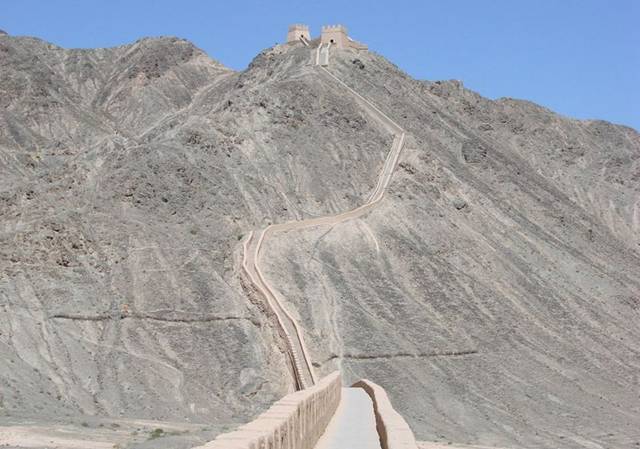The Great Wall Over The Years
Beginning in the 7th century BC, a series of massive defensive fortifications were constructed along China's northern border. Built to protect China from northern attacks, the walls stretched out for thousands of kilometers, many joining together to become the Great Wall of China. Over several centuries, the wall and thousands of supporting structures were built across mountains, deserts, and rivers, eventually stretching more than 20,000 kilometers in length. Sections of the wall near large cities are well-maintained, but many remote areas are slowly being reclaimed by nature. Gathered here are images of the Great Wall over the years, from its westernmost pass at Jiayuguan to where it meets the sea in Qinhuangdao.
A 14th century fortress at the Great Wall in Jiayuguan, on September 15, 2009. Original here.
A train moves through a break in the Great Wall of China, at Jiayuguan, built in the Ming Dynasty (1372 AD), once part of the Old Silk Road, photographed on October 14, 2003.
The western end of the Great Wall, near Jiayuguan, on May 30, 2007.
Remnants of the Great Wall at Shuidonggou, in Yinchuan, China.
A woman is helped to the top of a mound at the Dajingmen Great Wall, once used as a watchtower overlooking the historic garrison town of Zhangjiakou, some 180 kilometers north of Beijing, in China's northern Hebei province, on May 24, 2006. Unlike other Great Wall sites nearer to Beijing which have been restored for tourism, the wall around Dajingmen Gateway, which marked China's northern border dating back to the early Ming Dynasty (around 1368) and rebuilt again in 1546 during the Qing Dynasty, has been left largely untouched.
A taxi drives beside an ancient section of the Great Wall near Sanguan Pass, west of Yinchuan, by the foothills of the Helan Shan Mountains in Ningxia Hui Autonomous Region, on June 25, 2007.
A 124-mile (200-kilometer) stone section of the Great Wall along the middle of the Yinshan Mountains in central Inner Mongolia is shown in this April 1, 1998 photo. Discovered by archaeologists from the Inner Mongolia Autonomous Region, the section was part of the original wall built during the Qin Dynasty (221-207 BC).
An older section of the Great Wall, in Lengkou, near Qinhuangdao, China.
A battered section of the Great Wall of China, at Jinshanling, northeast of Beijing, is seen in this December 29, 1999 photo.
source The Great Wall Over The Years, Nice n Funny
Chinese hikers make their way up a section of the Great Wall that is decaying and overgrown with vegetation located near Xiang Shui Hu village, located 80 km (50 miles) northwest of Beijing, on September 30, 2012. Voted one of the New Seven Wonders of the World in 2007, the 6,400 km (4,000 miles) wall draws millions of tourists every year, mostly to restored sections near the capital, Beijing. But away from the tourist trail, some parts of the wall are being allowed to crumble away.
Naziyu Great Wall in autumn colors.
A deteriorating section of the Great Wall, north of Qinhuangdao.
Tourists visit Laolongtou, or Old Dragon's Head, section of the Great Wall in Qinhuangdao, Hebei Province, on July 9, 2009. Old Dragon's Head is the eastern end of the Ming Dynasty (1368-1644) Great Wall. It extends about 20 meters (66 feet) into the Bohai Sea like a dragon drinking water, hence its name.
source The Great Wall Over The Years, Nice n Funny








































